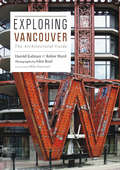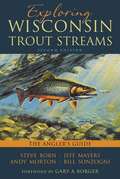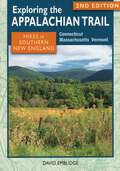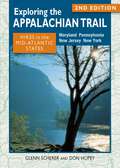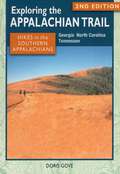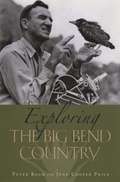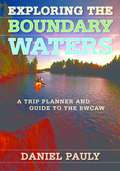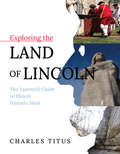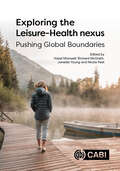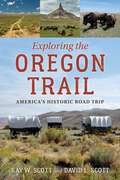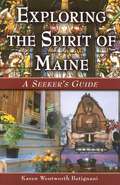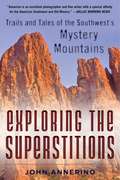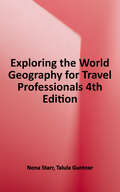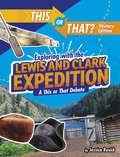- Table View
- List View
Exploring The Hospitality Industry (Third Edition)
by John R. WalkerExploring the Hospitality Industry helps readers advance in their careers by giving them a broad foundation of hospitality industry knowledge presented in a lively, visually appealing, engaging manner. The emphasis is on the people, companies, and positions that make up the hospitality industry today, and the focus on sustainability includes case studies on practitioners and corporations that engage and involve readers as they explore the trends in this ever-growing field. The book moves beyond just restaurants and hotels to cover all facets and segments of the industry, including new growth areas such as event management, meeting planning, cruising, theme parks, and gaming entertainment.
Exploring The World (Third Edition)
by Nona StarrThe third edition of Exploring the World is designed to serve the needs of students planning careers in the travel, tourism, and hospitality industry. The book presents information about the most commonly requested destinations from the viewpoint of professionals working in the industry.
Exploring Toronto: A Guide to 28 Unique Public Spaces
by Ken Greenberg Eti GreenbergA full-colour guide to dozens of unique outdoor spaces that highlight Toronto as a sustainable, liveable city.Toronto is rich in public spaces — deeply incised ravines, lively neighbourhoods, lush gardens and parks, iconic bridges, even repurposed industrial silos and undercrofts of elevated highways. Urban designer Ken Greenberg and Toronto aficionado Eti Greenberg have combed the city on foot and by tandem bike, discovering some of Toronto’s best outdoor public spaces.In Exploring Toronto, they have gathered twenty-eight of their favourite spots, each offering something unique — a flash of ingenious design, a surprise vantage point, or simply relief from the hum of traffic. Ken and Eti bring their distinctive perspective, informed by years of work in urban design, to each of their choices, providing readers (and explorers) with the full story of the history, design, and appeal of each one-of-a-kind place.
Exploring Vancouver
by John Roaf Mike Harcourt Harold Kalman Robin WardVancouver's streetscapes and neighbourhoods have changed drastically in recent years. New buildings representing current architectural trends are mixing with and often replacing those of earlier eras and tastes, and a maturing architectrual melange is emerging. This book invites the reader to explore the city's continually evolving urban landscape in a highly readable, yet authoritative, guide to its architecture.In this completely updated edition of Exploring Vancouver, with brand-new entries and accompanying photographs, Harold Kalman and Robin Ward have divided the city (including the North Shore, Richmond, Burnaby and New Westminster) into fourteen areas, selecting buildings and structures in these neighbourhoods that represent the best exakmples of the new and old architecture. Each area is preceded by an informative introduction that provides historical context for the entries that follow.There are over 400 entries, each featuring a short description that combines architectural, historical and social commentary. The prose is lively as the authors consider the new and the old, the modest and the grand, the attractive and the not-so-attractive in a wide-ranging work that encompasses everything from heritage to "monster" homes.This book is designed as a walking tour guide, with a map of each area showing the location of every entry.
Exploring Wisconsin Trout Streams: The Angler's Guide
by Steve Born Jeff Mayers Andy Morton Bill SonzogniDrawing on years of conservation and angling experience, Steve Born and Jeff Mayers tell you about great fishing opportunities unique to Wisconsin-1,000 miles of spring creeks, the amazing nocturnal Hex hatch, and big salmonids in the Great Lakes tributaries. They profile twenty of Wisconsin's finest streams-from the bucolic Green River in the southwest to the historic and wild Bois Brule in the north. This new edition includes updates throughout, new photos, and a new chapter detailing improvements in
Exploring the Appalachian Trail: Hikes in Southern New England (Exploring the Appalachian Trail)
by David EmblidgeA guide to 27 great day hikes and overnight backpacking trips on the Appalachian Trail in Connecticut, Massachusetts, and Vermont.
Exploring the Appalachian Trail: Hikes in the Mid-Atlantic States (Exploring the Appalachian Trail)
by Glenn Scherer Don Hopey41 day hikes and overnight trips in Maryland, Pennsylvania, New Jersey, and New York.
Exploring the Appalachian Trail: Hikes in the Southern Appalachians (Exploring the Appalachian Trail)
by Doris Gove32 day hikes and overnight trips in Georgia, North Carolina, and Tennessee.
Exploring the Appalachian Trail: Hikes in the Virginias (Exploring the Appalachian Trail)
by David Lillard Gwyn HicksA guide to 46 day hikes and overnight trips in Virginia and West Virginia.
Exploring the Big Bend Country
by Price Peter Koch June CooperIn this highly readable book, Koch's daughter June Cooper Price draws on the newspaper columns her father wrote for the Alpine Avalanche, supplemented by his photographs, journal entries, and short pieces by other family members, to present Peter Koch's vision of the Big Bend.
Exploring the Boundary Waters: A Trip Planner and Guide to the BWCAW
by Daniel PaulyWith more than 200,000 visitors annually, the Boundary Waters Canoe Area Wilderness is among the most alluring wilderness areas in the country, unique because it is most often explored by canoe. Comprised of more than one million acres, the BWCAW is an exceptional combination of expansive wilderness, abundant wildlife, and fascinating natural and human history. Exploring the Boundary Waters is the most comprehensive trip planner to the BWCAW, giving travelers an overview of each entry point into the wilderness area as well as detailed descriptions of more than one hundred specific routes—including a ranking of their difficulty level and maps that feature the major waterways, portages, and the designated campsites. The book is crafted so that readers can design their own route through the almost inexhaustible network of lakes and streams. Daniel Pauly, Boundary Waters expert, worked with the U.S. Forest Service, the Minnesota DNR, and local outfitters to collect and present crucial information here: instructions on about how to obtain a permit, the rules and regulations of the park, safety tips, and suggestions about how to help maintain the ecological integrity of the wilderness. As engaging as it is informative, Exploring the Boundary Waters not only contributes advice on the pros and cons of each route, but also brings the reader a natural and historical context for the journey by offering insight into the pictographs, mining sites, logging railroads, and ruins one may encounter on an expedition. With its accessible and personal style, Exploring the Boundary Waters is the perfect guide for anyone—novice or seasoned veteran—arranging a trip to the BWCAW. A companion Web site for this book, http://www.boundarywatersguide.com, presents useful information that can be downloaded for planning a trip, including gear lists, overview maps, and route updates.
Exploring the Fife Coastal Path: A Companion Guide
by Hamish BrownThis is the ideal guide to the whole route, so rich in history and natural beauty. Designed to be used by walkers on the Path or visitors to any point along it, it introduces a wealth of castles, churches, harbors, monuments and red-roofed houses. Hamish Brown gives practical advice on all aspects of walking the Path, whether you are making a seven-day trip along its whole length or walking a short section on a Sunday afternoon. Revising his earlier guide to the route, he explores every part of the Fife coast, including the famous Forth bridges, the charming East Neuk fishing villages of Pittenweem, Elie and St Monans, as well as Anstruther, Crail and St Andrews. Along the way he provides a mass of fascinating information about people and places that can be read for pleasure and kept as the souvenir of a unique and unforgettable part of Scotland.
Exploring the Geology of the Carolinas: A Field Guide to Favorite Places from Chimney Rock to Charleston (Southern Gateways Guides)
by Kevin G. Stewart Mary-Russell RobersonHow were the Appalachian Mountains formed? Are the barrier islands moving? Is there gold in the Carolinas? The answers to these questions and many more appear in this reader-friendly guide to the geology of North Carolina and South Carolina. Exploring the Geology of the Carolinas pairs a brief geological history of the region with 31 field trips to easily accessible, often familiar sites in both states where readers can observe firsthand the evidence of geologic change found in rocks, river basins, mountains, waterfalls, and coastal land formations.
Exploring the Hamakua Coast: A Pictorial Guide to the Plantation Era
by Ken OkimotoThe Hamakua Coast is the backdrop of a plantation town when locomotive steam engine, one-room school and one-lane bridges were in existence on the big island of Hawaii.
Exploring the Hospitality Industry
by John R. WalkerThis print textbook is available for students to rent for their classes. The Pearson print rental program provides students with affordable access to learning materials, so they come to class ready to succeed. For introductory courses in hospitality. Empower tomorrow's hospitality leaders Exploring the Hospitality Industry fills a vital need: to broadly cover the hospitality industry and provide a dynamic introduction for hospitality management students. More practical than theoretical, the text addresses the latest trends across hospitality segments - from the traditional realms of tourism, hotels, and restaurants, to growth areas such as event management. <p><p>The 4th edition examines the latest careers, operations, and management principles within each featured segment. Drawing on new learning outcomes, it analyzes the industry's newest developments and challenges, while refreshing content to reflect ever-evolving roles and practices. Exploring the Hospitality Industry, 4th edition is also available via Revel(tm), an interactive learning environment that enables students to read, practice, and study in one continuous experience.
Exploring the Land of Lincoln: The Essential Guide to Illinois Historic Sites
by Charles TitusDiscovering Illinois through twenty of the state's most important places A one-of-a-kind travel guide, Exploring the Land of Lincoln invites road-trippers and history buffs to explore the Prairie State's most extraordinary historic sites. Charles Titus blends storytelling with in-depth research to highlight twenty must-see destinations selected for human drama, historical and cultural relevance, and their far-reaching impact on the state and nation. Maps, illustrations, and mileage tables encourage readers to create personal journeys of exploration to, and beyond, places like Cahokia, the Lincoln sites, Nauvoo, and Chicago's South Side Community Art Center. Detailed and user-friendly, Exploring the Land of Lincoln is the only handbook you need for the sights and stories behind the names on the map of Illinois.
Exploring the Leisure - Health Nexus: Pushing Global Boundaries
by Lynn Anderson Simon Darcy Simone Grabowski Jenny Onyx Tonia Gray Katherine Dashper Torben Nielsen Joyce Simard Nina Burridge Holly Bowen-Salter Christina Davies Leila Gholizadeh Sara Karacsony Alexis Marcoux Rouleau Danielle McDonald Annette Michelsen Cour Emma Milanese Carmel Nottle Michelle O’Shea Victoria Paraschak Sonya Pearce Melanie Pescud Arianne Reis Zoei SuttonBy exploring past, current, and future intersections between leisure and health, this book considers research and academic thought to reveal and critique the nuanced ways that leisure impacts health as well as considering how health professions use leisure as a 'tool'. Aided by the diverse chapters, readers will be challenged to explore future intersections between leisure and health using an overarching eco (ecological/environmental), bio(biological), psycho (psychological), social (sociological) lens. Many of the chapters include case-studies which consider further developing leisure and health themes, particularly in relation to a number of emerging environmental, health and societal challenges that confront the world. In addition, the book: ·Is cross disciplinary and demonstrates non-individualized framing of health (as per the WHO definition) giving readers a unique opportunity to develop an understanding of sociological frameworks, including ecobiopyschosocial, salutogenic, multi-species and criticalist. ·Moves readers from an individual level understanding of interconnections between leisure and health through to a consideration of global issues (including a section on the impact and consequences of Covid-19). ·Examines the nexus between leisure and health through a focus on a number of population groups including First Nations peoples, women, incarcerated people, migrants, people with disabilities, older people, and the human-animal interface. The book will be of significant interest to researchers/academics/practitioners in the leisure, health, sport, tourism, recreation, events, social science, and arts disciplines.
Exploring the Oregon Trail: America's Historic Road Trip
by David L. Scott Kay W. ScottThe Oregon Trail, the route of the pioneers during the largest mass migration in United States history, was a long and difficult journey made by Americans nearly two centuries ago. This guidebook, rich with photos, interviews, and information about the famous landmarks, facilities, individuals, activities, and towns along the trail, will please both adventurers planning to travel the trail and individuals who wish to learn about and follow the trail from an easy chair. Complete with maps and details of each state from Missouri to Oregon, Exploring the Oregon Trail will give readers everything needed to follow in the footsteps of the American pioneers.
Exploring the Social Impacts of Events (Routledge Advances in Event Research Series)
by Greg Richards Marisa P. de Brito Linda WilksSocial impacts are increasingly used as one of the main justifications for staging and funding events, and yet there is very little empirical evidence on the extent to which these impacts are realised by different kinds of events or in different settings. This timely volume fills this gap by being the first to explore the different social aspects of events, looking in particular at the role of events in developing social capital, social cohesion and participation in local communities. Based on cutting edge empirical research, it evaluatesthe contribution of both cultural and sports events to social capital, social cohesion, community spirit and local pride in range of different types of events and settings, with case studies drawn from Europe, Australia and South Africa. It therefore furthers knowledge about the social benefits and impacts of events and significantly contributes to the development of Events as a discipline. Written by leading academics in this area, this volume is essential reading for all those interested in Events Management and Studies.
Exploring the Spirit of Maine
by Karen BatignaniExploring the Spirit of Maine is a unique travel guide and reference book for those seeking either traditional or non-traditional options for spiritual and/or inner development. Author Karen Batignani reveals Maine's rich and varied religious history along with contemporary spiritual offerings: an ashram in Industry, a yoga retreat in Island Falls, Franciscan Friars in Kennebunk, two schools for shamanism and one that ordains high priestesses are just a few of the surprises Batignani found while mapping the spiritual landscape of Maine. In her travels, she discovered non-mainstream religions, Eastern traditions, spiritual communities, schools, retreats, and sacred architecture. The result is a selection of 45 interesting offerings that are covered in enough depth to satisfy the spiritually curious and enable those who are seeking spiritual community to fit right in. Batignani includes contact information for each entry, along with a summary list of recommended readings.
Exploring the Superstitions: Trails and Tales of the Southwest's Mystery Mountains
by John AnnerinoArizona’s Superstition Mountains are like no other mountain range in the continental United States. The ancestral ground of the western Apache and sacred heights of the neighboring Pima, these mountains were once a veritable no-man’s land of soaring cliffs, dead-end box canyons, and eerie hoodoos of stone, marking them as one of the last places on earth that any person would dare to tread. While this range appears on the surface to be a veritable nature lover’s paradise with towering saguaro cactus forests, desert wildflowers, and roadrunners, it is also home to rattlesnakes, plants and animals that stick, sting, or bite, and modern gun-toting, dry-gulchers. In fact, in the last century, the Superstition Mountains have claimed the lives of more than 500 visitors, marking it as the West’s deadliest wild area. Part hiking guide, part history book, Superstitions: Hiking the Ghost Trails of Mystery Mountain vividly brings the supernatural beauty, mystery, and majesty of this unique area to life. Within the pages of Superstitions, readers will first be swept up in the legends of the Superstition Mountains, encountering colorful historical characters such as 1840s gold prospectors, brave-hearted Apaches, and sly outlaws. Readers will encounter the native flora and fauna of the range, from poisonous rattlesnakes to rare flowers. And finally, an in-depth guide to every trail in the range, will satisfy even the most experienced of hikers. Including a foldout map and dozens of original photos, Superstitions belongs on the shelf, or in the backpack, of every history buff and every veteran hiker.
Exploring the Use and Impact of Travel Guidebooks
by Anders Sørensen Victoria PeelThis volume provides the first comprehensive examination of travel guidebooks and their conceptualisation, use and impact. Guidebooks have been key tourism paraphernalia for almost two centuries and although researched in some areas, academic knowledge on guidebooks in tourism has not been expansively communicated. The uncritical, unreflective and largely pejorative approach to guidebooks in the public sphere, and to some degree also present in academia, is reassessed in this book. This challenges the current limited tourism research approaches to the topic, including the routinely held assumption that the internet has all but destroyed the printed guidebook. This book will be a useful resource for postgraduate students and researchers in tourism and tourism communications and consumption.
Exploring the World of J. S. Bach: A Traveler's Guide
by Traute M. Marshall Robert L. MarshallA singular resource, Exploring the World of J. S. Bach puts Bach aficionados and classical music lovers in the shoes of the master composer. Bach scholar Robert L. Marshall and veteran writer-translator Traute M. Marshall lead readers on a Baroque Era odyssey through fifty towns where Bach resided, visited, and of course created his works. Drawing on established sources as well as newly available East German archives, the authors describe each site in Bach's time and the present, linking the sites to the biographical information, artistic and historic landmarks, and musical activities associated with each. A wealth of historical illustrations, color photographs, and maps supplement the text, whetting the appetite of the visitor and the armchair traveler alike.
Exploring the World: Geography for Travel Professionals
by Nona Starr Talula GuntnerExploring the World opens the world to you like no other geography course you have experienced. While the “science” of geography is unavoidable, you will see the world as travel folks see it … as a kaleidoscope of places, people, and experiences just waiting to be sampled.
Exploring with the Lewis and Clark Expedition: A This or That Debate (This or That?: History Edition)
by Jessica RusickIn 1804, Meriwether Lewis, William Clark, and their team set out on an exciting yet challenging expedition into the American West. They faced many difficult choices along the way. Now the choices are yours. Would you rather discover new animals or new plants, both of which could cause you harm? Would you rather be caught in a flash flood or a blinding snowstorm? Would you rather risk crossing rugged mountain terrain or going down rapids in a canoe? It's your turn to pick this or that!



